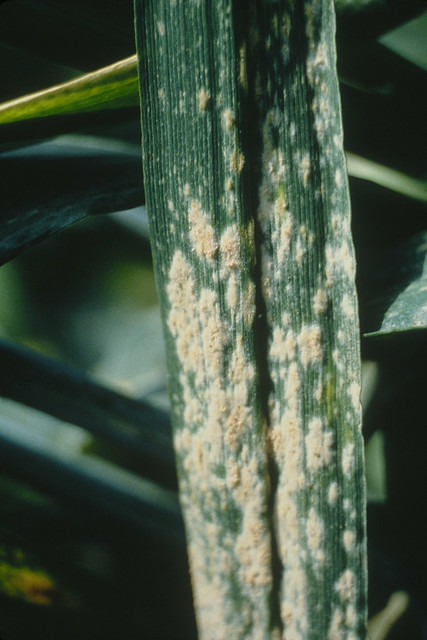Wheat leaf showing fungal growths due to powdery mildew (Blumeria graminis). These are initially white to pale gray, while older fungal tissue turns yellowish gray, as shown. They consist of fuzzy or powdery colonies of mycelia and conidia, on the upper surfaces of leaves and leaf sheaths (especially on lower leaves), and sometimes on the spikes. This superficial fungal material can be rubbed off easily with the fingers. Host tissue beneath the fungal material becomes chlorotic or necrotic and, with severe infections, the leaves may die. Cladus: Eukaryota Blumeria graminis is a fungus that causes powdery mildew on grasses, including cereals (called barley powdery mildew or corn mildew). It is the only species in the genus Blumeria. It has also been called Erysiphe graminis and (by its anamorph) Oidium monilioides or Oidium tritici. Systematics Previously B. graminis was included within the genus Erysiphe, but the molecular studies have placed it into a clade of its own. Blumeria differs from Erysiphe in its digitate haustoria and in details of the conidial wall. Eight special forms or formae speciales (ff.spp.) of B. graminis have been distinguished, each of which is parasitic on a particular genus of grasses. Those that infect crop plants are B. graminis f.sp. tritici, which causes powdery mildew of wheat and infects other grasses in the genera Triticum and Aegilops, f.sp. hordei on barley, f.sp. avenae on oats and f.sp. secalis on rye. Other formae speciales are pathogenic on wild grasses, including agropyri on grasses in the genera Agropyron and Elymus, bromi on Bromus spp., poae on Poa spp. and lolii on Lolium spp. (ryegrass). Morphology The mycelium can cover the plant surface almost completely, especially the upper sides of leaves. Ascocarp is dark brown, globose with filamentous appendages, asci oblong. Ascospores hyaline, ellipsoid, 20-30 x 10-13 µm in size. Anamorph produces on hyaline conidiophores catenate conidia of oblong to cylindrical shape, not including fibrosin bodies, 32-44 x 12-15 µm in size. Haustoria are palmate. Ecology Blumeria graminis disperses by scattering conidia and ascospores. It is biotrophic, and does not grow on synthetic media. Relatively cool and humid conditions are favourable for its growth. Its relatively great genetic variability enables it often to infect previously resistant plant varieties. Genetics The genome of Blumeria graminis f. sp. hordei has recently been sequenced. [1] References * Pietro D. Spanu et al., Genome Expansion and Gene Loss in Powdery Mildew Fungi Reveal Functional Tradeoffs in Parasitism, in: Science. December 10, 2010[2] Source: Wikipedia, Wikispecies: All text is available under the terms of the GNU Free Documentation License |
|

